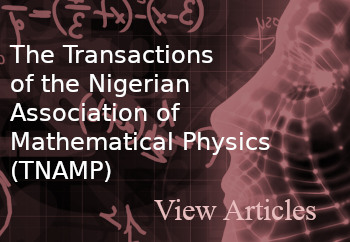BIOMECHANICAL DYNAMICS OF SEVERE ACUTE RESPIRATORY SYNDROME (SARS) AND THE PREDICTION OF INBUILT RAISING MULTIPLIER λ.
Keywords:
harmonics, vibration, SARS-CoV-2, constitutive carrier wave, parasitic wave, Host wave, AttenuationAbstract
Dynamical quantities such as energy, pressure-gradient, velocity-profile, make up the biomechanics of the human system, and the attenuation induced by localized and non-localized infectious diseases causes a malfunction in these quantities. In this work, we establish that every living and non-living matter possess vibration, and vibration produces wave. Thus Man (host) and the virus or bacteria (parasite) have their own independent characteristic vibrations. We first superpose the parasitic wave on the host wave and the resultant constitutive carrier wave, is studied using Fourier transform method. We used the characteristic variants of the human and parasitic vibrations to determine the general influence of localized infectious diseases in the human viscoelastic system. It is shown in this work, that SARS and other related localized infectious diseases has an incubation period of about 9 to 30 days, depending on the nature and circumstances of the host wave under attack. This is indicated by several of the spectra, but most importantly the high peak resonance in the spectra of the total phase angle, displacements and velocities for lower and higher harmonics. Also, it is shown in this work that the effect of SARS or any form of localized human infectious diseases become more complicated after about 100 days of infection.
Downloads
References
Muhammed H., Ziaul H., Mashiyat T. and Shahin S. (2020). COVID-19 and the environment: A critical review and research agenda. Sci. of the Total Environment, Vol 475, 25 https://doi.org/10.1016. Scitotenv. 2020. 14102.
Garcia-Beltran WF, Lam EC, Denis KS, Nitido AD, Garcia ZH, Hauser BM,, et al. (2021). “Multiplier SARS-CoV-2 variants escape neutralization by vaccine-induced humoral immunity”. Cell, 2021, 184: 2372 – 2383.e9.
Wang P., Nair MS, Liu L., Iketani S., Luo Y., Guo Y. (2020). “Antibody resistance of SARS-CoV-2 variants B.1.351 and B.1.1.7. Nature 2021: 593: 130 – 135.
Almand A., Moore M. and Jaykus L (2017). “Virus – Bacteria Interactions: An Emerging Topic in Human infection. Multidisplinary Digital Publishing Institute (MDPI) 9(3): 58. Doi:10.3390/v9030058
Schultze and Aschenbren, (2021). “COVID-19 and the human innate immune system. Cell Vol: 184, 1671 – 1692.
Nave O. Hartuv I, Shemesh U. (2020). “???? − ???????????????????????? mathematical model of Covid 19-stability analysis using fast – slow decomposition. Peer J. 8:e10019DOI 10, 7717/peerj. 10019.
Tada T, Zhou H, Samanovic MI, Dcosta BM, Cornelius A, Herati RS (2022). “Neutralization of SARS-CoV-2 Variants by mRNA and adenoviral vector vaccine-elicited antibodies. Front Immunol”. https://ec.europa.eu/transparency/documents.register/detail?
Knight J. Mishra S. (2020). “Estimating effective reproduction number using generation time versus serial interval, with
application tocovid-19 in the Greater Toronto Area, Canada. Infect Dis model5: 889 – 896. PubMed PubMed Central Google Scholar.
Enaibe A. E. and Idiodi J. O. A. (2013). The biomechanics of HIV/AIDS and the prediction of Lambda λ Int. J. of Engineering and Science. 2, 43 – 57.
Egboro A. Sharon (2023). “A mathematical modeling of the biomechanics of severe acute respiratory syndrome, coronavirus-2 (SARS-CoV-2)” Ph.D Thesis, unpublished.
Downloads
Published
Issue
Section
License
Copyright (c) 2023 The Journals of the Nigerian Association of Mathematical Physics

This work is licensed under a Creative Commons Attribution-NonCommercial-ShareAlike 4.0 International License.




